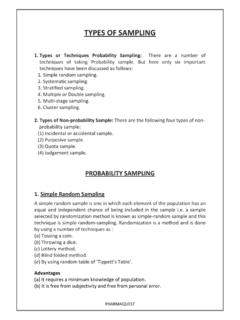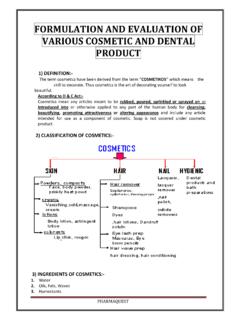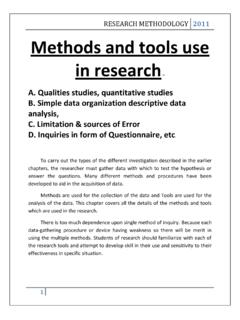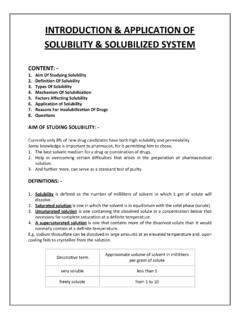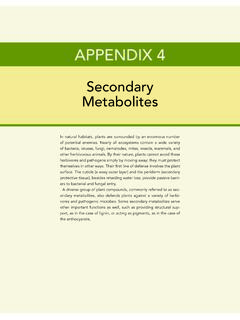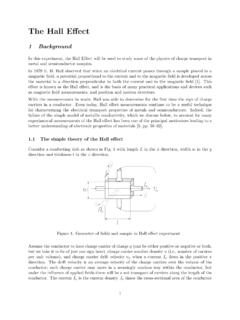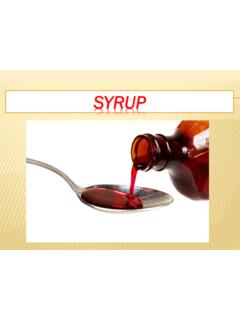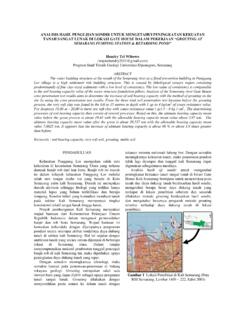Transcription of Importance, Objectives & Factors Affecting Dissolution ...
1 Importance, Objectives & Factors Affecting Dissolution Rate, Theories of Dissolution And Official Dissolution Tests (Equipments of Dissolution Study) LIST OF CONTENTS Introduction Importance & applications Factor Affecting Dissolution rate 1. Physicochemical Properties of Drug 2. Drug Product Formulation Factors 3. Processing Factors 4. Factors Relating Dissolution Apparatus 5. Factors Relating Dissolution Test Parameters Theories of Dissolution 1. Diffusion layer model (Film theory) 2. Danckwert s model (Penetration or Surface Renewal theory) 3.
2 Interfacial barrier model (Double Barrier Mechanism or Limited Solvation theory) Various official Dissolution tests Question bank References INTRODUCTION Definition:- Dissolution rate may be defined as amount of drug substance that goes in the solution per unit time under standard conditions of liquid/solid interface, temperature and solvent composition. It can be considered as a specific type of certain heterogeneous reaction in which a mass transfer results as a net effect between escape and deposition of solute molecules at a solid surface.
3 The processes involved in Dissolution of solid dosage forms: IMPORTANCE AND APPLICATIONS IMPORTANCE (Need of Dissolution ).. 1. Results from in-vitro Dissolution rate experiments can be used to explain the observed differences in in-vivo availability. 2. Dissolution testing provides the means to evaluate critical parameters such as adequate bioavailability and provides information necessary to formulator in development of more efficacious and therapeutically optimal dosage forms. 3. Most sensitive and reliable predictors of in-vivo availability.
4 4. Dissolution analysis of pharmaceutical dosage forms has emerged as single most important test that will ensure quality of product. 5. It can ensure bioavailability of product between batches that meet Dissolution criteria. 6. Ensure batch-to-batch quality equivalence both in-vitro and in-vivo, but also to screen formulations during product development to arrive at optimally effective products. 7. Physicochemical properties of model can be understood needed to mimic in-vivo environment. 8. Such models can be used to screen potential drug and their associated formulations for Dissolution and absorption characteristics.
5 9. Serve as quality control procedures, once the form of drug and its formulation have been finalized. NOTE: Simulated test modification done as per need If hydrophobic drug than the sodium lauryl sulphate can be added into simulated fluid to solublize the drug. For erodible tablet speed of agitation is bit high because it requires external force. HGC capsule shell forms swollen rubbery mass when comes in contact with physiological fluid so dissolve the shell by using enzyme like pepsin & pancreatin. In case of SGC capsule where content is oily we add tween 80.
6 To study the effect of food we can add vegetable oil. In case of encapsulated product, material first removed & then studied separately. spenshul. APPLICATIONS 1. PRODUCT DEVELOPMENT Important tool during development of dosage form. Aids in guiding the selection of prototype formulations and for determining optimum levels of ingredients to achieve drug release profiles, particularly for extended release formulations. Also guides in selection of a market-image product to be used in pivotal in-vivo bioavailability or bioequivalence studies.
7 2. QUALITY ASSURANCE performed on future production lots and is used to assess the lot-to-lot performance characteristics of drug product and provide continued assurance of product integrity/similarity. 3. PRODUCT STABILITY In-vitro Dissolution also used to assess drug product quality with respect to stability and shelf-life. As product age, physicochemical changes to the dosage form may alter Dissolution characteristics of drug product over time. For some products, polymorph transformations to more stable, and hence less soluble crystalline forms may result in reduced Dissolution rates.
8 4. COMPARABILITY ASSESSMENT Also useful for assessing the impact of pre- or post- approval changes to drug product such as changes to formulation or manufacturing process. Thus, in-vitro comparability assessment is critical to ensure continued performance equivalency and product similarity. 5. WAIVERS OF IN-VIVO BIOEQUIVALENCE REQUIREMENTS In-vitro Dissolution testing or drug release testing may be used for seeking waiver of required product to conduct in-vivo bioavailability or bioequivalence studies. Factors Affecting Dissolution RATE 1.
9 Physicochemical Properties of Drug 2. Drug Product Formulation Factors 3. Processing Factors 4. Factors Relating Dissolution Apparatus 5. Factors Relating Dissolution Test Parameters 1. PHYSICOCHEMICAL PROPERTIES OF DRUG 1) DRUG SOLUBILITY Solubility of drug plays a prime role in controlling its Dissolution from dosage form. Aqueous solubility of drug is a major factor that determines its Dissolution rate. Minimum aqueous solubility of 1% is required to avoid potential solubility limited absorption problems. Studies of 45 compound of different chemical classes and a wide range of solubility revealed that initial Dissolution rate of these substances is directly proportional to their respective solubility.
10 Fig shows a log-log plot of solubility of several drug Vs their corresponding intrinsic rates of Dissolution at infinite rotation speed. Evident from graph that compounds with high solubility exhibit significantly higher Dissolution rates. 2) SALT FORMATION It is one of the common approaches used to increase drug solubility and Dissolution rate. It has always been assumed that sodium salts dissolve faster than their corresponding insoluble acids. Eg. sodium and potassium salts of Peniciilin G, sulfa drugs, phenytoin, barbiturates etc.
